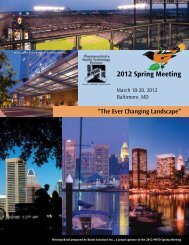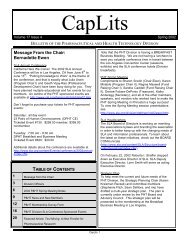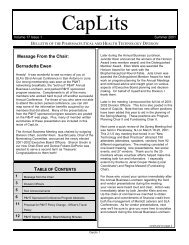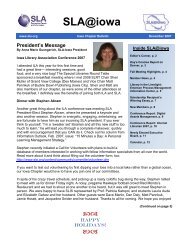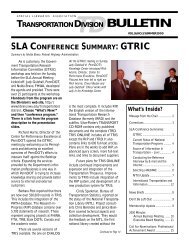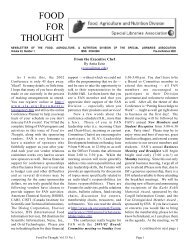Education Libraries - Special Libraries Association
Education Libraries - Special Libraries Association
Education Libraries - Special Libraries Association
You also want an ePaper? Increase the reach of your titles
YUMPU automatically turns print PDFs into web optimized ePapers that Google loves.
the archives as they began to pile up. The present<br />
location for the K-State at Salina Library Archives<br />
collection consists of a room behind the library<br />
offices measuring approximately 19 ft by 16 ft.<br />
The collection room is walled off by one office<br />
filled with filing cabinets, with a 6 ft wide hallway<br />
which leads out into a library staff lounge. It<br />
consists of nine green photo boxes containing<br />
about 11,000 photos and forty-one photocopy<br />
boxes full of various scrapbooks and college<br />
memorabilia.<br />
Getting Started<br />
Before re-organizing the<br />
archives, the librarians<br />
conducted research on<br />
possible options for<br />
preserving the photos, with<br />
a specific emphasis on best-practice methods<br />
regarding the handling and displaying of the<br />
artifacts. They soon realized that the Internet and a<br />
few books would not provide sufficient<br />
information, and sent one librarian to attend the<br />
2008 Kansas Library Conference for further<br />
guidance on preservation. She also visited the<br />
Salina Public Library to discuss preservation<br />
techniques with the resident archivist. Since<br />
education is a continuous process, she will also be<br />
attending the 2008 Midwest Archives Conference<br />
Fall Symposium to learn about digital<br />
preservation.<br />
After attending the<br />
conferences and<br />
brainstorming with<br />
other librarians, the<br />
archive librarian was<br />
confident in the<br />
staff’s ability to<br />
organize the archives<br />
into a useable<br />
collection and a<br />
portion of the<br />
library’s general<br />
budget was set aside<br />
for archival supplies<br />
by the director.<br />
Fireproof file cabinets<br />
and acid-free boxes<br />
were deemed crucial<br />
Stripped of its original context,<br />
an old photograph is reduced<br />
to mere curiosity<br />
to save and store the collection and will be ordered<br />
at regular intervals over several consecutive years.<br />
In addition to the photographs, the filing cabinets<br />
will be home to university paperwork, course<br />
descriptions, faculty files, information about<br />
college mergers and name changes, college<br />
handbooks, flight records, and other miscellaneous<br />
papers. A sizeable collection of yearbooks was<br />
also discovered in some older filing cabinets in the<br />
archives. Extra copies were sent to the local public<br />
library and the Smoky Hills Genealogical Museum<br />
to fill holes in each collection. Should a natural<br />
disaster or fire occur and damage the collection on<br />
campus, there will be copies<br />
located in different facilities<br />
around the county so the<br />
history of the college would<br />
not be completely lost.<br />
Gathering supplies<br />
Having secured new homes for the photos in acidfree<br />
boxes and fire-proof file cabinets, the next<br />
step was to purchase supplies for handling the<br />
collection. The first box revealed the presence of<br />
multiple sizes of photos in the inventory. Print<br />
sleeves were purchased in two different sizes, 3x5<br />
inches (100) and 8x10 inches (25), to prevent<br />
fingerprints from damaging the photographs.<br />
Next, acid-free marking pens were used so names,<br />
dates, places, and topics can be written on the<br />
back of the photo as the photo’s subjects are<br />
identified. For<br />
example, if the picture<br />
contained a lecturer<br />
and an audience, the<br />
speaker’s name, the<br />
occasion he or she was<br />
speaking at, the place<br />
and the date would be<br />
recorded. Multiple<br />
pairs of white cotton<br />
gloves were ordered as<br />
well to protect the<br />
integrity of the<br />
materials during the<br />
sorting until they<br />
found a permanent<br />
home in the cabinets,<br />
as well as for handling<br />
the materials while<br />
<strong>Education</strong> <strong>Libraries</strong>, Volume 31, No. 2, Winter 2008 34




